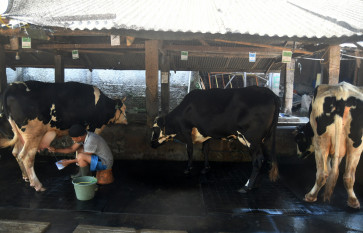Popular Reads
Top Results
Can't find what you're looking for?
View all search resultsPopular Reads
Top Results
Can't find what you're looking for?
View all search resultsBean battle for Indonesian palates
Fresh start: Mohamad Isman, treasurer of Malang’s Primkopti Bangkit Usaha (boosting business co-op), says lupin tempeh tastes different than the tempeh made with soybeans
Change text size
Gift Premium Articles
to Anyone

F
span class="caption">Fresh start: Mohamad Isman, treasurer of Malang’s Primkopti Bangkit Usaha (boosting business co-op), says lupin tempeh tastes different than the tempeh made with soybeans. Duncan Graham
A robust multimillion-dollar bid by Western Australian lupin growers to penetrate Indonesia’s tempeh market is taking a long time to ferment. Duncan Graham reports from Sanan, Malang’s famous home industry kampong.
More than two years ago, an Australian trade mission sat down in Jakarta to a serving of tempeh. So what? Only that the meal used lupins, not soybeans imported from the US. Media reports on the VIP lunch claimed the product was ‘expected to become commercially available in Indonesia in coming months’.
Those months are a long time coming. Despite extensive university research and promotion, the Australians still have to convince Indonesian tempeh manufacturers that lupins are the future.
“The taste is different, and whether that’s good or bad depends on the individual,” said Mohamad Isman, treasurer of Malang’s 500-member Primkopti Bangkit Usaha (boosting business co-op), while running through a parade
of Australian politicians’ and bureaucrats’ names in his visitor’s book.
“The problem is that lupin tempeh is hard and doesn’t absorb water [prior to cooking at home]. I haven’t tried it but that’s what our members say. Research is good, but it’s word-of-mouth that’s important in Indonesia.
“Whether we start using it or not depends on many things, such as the continuing availability of soybeans and the price of lupins — which we don’t know.”
The lupin bulk price in Western Australia is AUD$355 (US$369.63) a ton. The world price for soybeans is fickle, currently around US$570, but the industry is predicting a hefty jump.
Strangely, soybean sales aren’t taxed — lupins are at 10 percent, a problem for traders. When the Western Australia push started, lupins were quoted at 20 percent cheaper than imported soybeans.
Close to East Java, underpinned by an active 22-year-old Sister-State relationship, are Western Australia grain growers who have topped 750,000 tons of lupins annually though the forecast this year is below 300,000 tons, mainly for stockfeed. They produce 80 percent of the world output.
More lupins would be planted if there was a stable higher-price human food market.
Western Australia is a big state with few people, and has to export to survive. East Java is a small province with a huge and hungry population, importing to live. A win-win fit? If only.
In what Indonesia claims is a bid for food self sufficiency, the government has been rapidly ring-fencing so many imports that this month the US filed a complaint at the World Trade Organisation (WTO). Australia may join the dispute.
Assuming these quicksands can be crossed, and that sour soybean traders don’t start a political or smear campaign against a rival product, lupin tempeh still has to pass the toughest tests of all — manufacture and taste.
“There’s no doubt that technical support is required to help tempeh makers achieve the correct process, just the same as with any new never-seen-before product,” said David Fienberg, managing director of Australasian Lupin Processing.
“We’ve completed many technical trials in and around Jakarta and in Surabaya. We’ve developed a simple, easy-to-use recipe which makes a very good tempeh. The taste is good — if not better — than soybean tempeh.”
Most trials have involved a mix of lupins and soybeans. A de-hulling and splitting plant has been built in Perth using processes so secret access was denied to The Jakarta Post.
Fienberg said a training program would be run among the nation’s tempeh producers starting around May emphasizing that lupins are drier, safer, have higher health values and come de-hulled.
However, Isman said this was no advantage because the beans still had to be boiled. “The prices are not so significant,” said Isman, picking stalks out of the American soybeans.
“The co-op board has yet to make a decision but I think that as long as soybeans are available from the US we’ll continue to use them. At this stage I don’t see the benefit. Taste is everything.”









